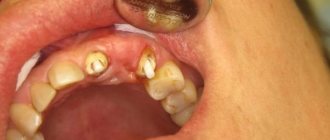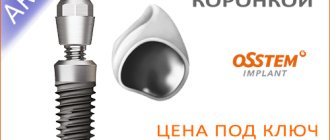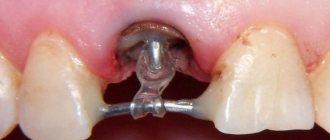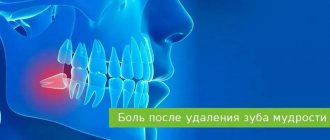Home » All about modern dentistry » Pain management in dentistry » Complications of local injection anesthesia The use of local injection anesthesia can cause complications of a general and local nature. The most common local complications are the occurrence of hematoma and limited movement of the joint, damage to the vessel, breakage of the injection needle, injury to the nerve trunk, ruptures in muscle tissue, swelling and pain after injection, paresis of facial muscles, tissue necrosis, diplopia. Possible general complications are poisoning with anesthetic solution, anaphylaxis and anaphylactic shock.
Headache after visiting the dentist
Visiting the dentist is a very unpleasant experience. Having headaches after visiting the dental office is a common occurrence. If a doctor removes or prescribes treatment for a diseased tooth, a headache may occur.
The reasons for this may be the following:
- Side effect from medications;
- Severe dental disease;
- Poor oral health;
- A large number of teeth undergoing treatment;
- Poor condition of the body as a whole, the presence of chronic diseases;
- Senile age of the patient;
Most often, pain caused by the cessation of the painkiller goes away on its own. If the pain only gets worse, you need to take an analgesic and consult a specialist for advice.
One of the possible causes of headaches may be the removal of a diseased tooth. Headaches occur especially often when a wisdom tooth is removed (the procedure is not always simple). This type of operation tends to damage bone tissue and gums, which leads to pain.
When correcting a malocclusion, headaches often appear. Pain can be of various types:
- Pain in the ear area;
- The occurrence of pain in the temporal part of the head;
- The occurrence of pain in the occipital part;
If you follow clear treatment instructions, this type of headache goes away in a short time.
Possible complications
Complications after implantation can be early and late, which appear much later than the day when the operation was performed. The latter can appear even after one or two months. The following body reactions are considered absolutely normal: swelling at the intervention site, pain, slight increase in temperature, slight chills, weakness and drowsiness, and the appearance of a hematoma.
To prevent the development of more serious complications, the doctor must adhere to a specific treatment protocol and act in conditions of absolute sterility. The final result of treatment also depends on the patient, so he must follow some recommendations. For example, at first you should not smoke or drink alcoholic beverages. It is also necessary to take medications prescribed by a specialist, this will reduce the risk of inflammation and pain.
After the operation, cold should be applied to the place where the implant was implanted. It is also worth rinsing your mouth with special solutions with an antiseptic effect. It is very important to remember to regularly brush your teeth, floss and rinse after every meal. For a while, it is recommended to give up strong coffee and tea, visiting the sauna and staying in the open sun. During the period of osseointegration, it is extremely important to lead a calm and measured lifestyle, then the likelihood of headaches and other complications will be minimal.
previous post
How long can you walk without a tooth before implantation?
next entry
Headaches after using anesthesia
Very often, dentists use local anesthesia when treating teeth. After undergoing anesthesia, many patients experience headaches. There are several reasons for this type of pain:
- Presence of intolerance to anesthesia or incorrect choice of medication;
- Location of the diseased tooth in remote places;
Most often, the headache is aching in nature and tends to increase when moving the head.
If headaches began after the extraction of a diseased tooth, it is necessary to find the cause of the pain; it may be a complication of the operation.
Headache due to complications arising after dental intervention
Many patients experience headaches after visiting the dentist. Various factors can contribute to the appearance of pain symptoms:
- The appearance of complications that manifested themselves during dental treatment;
- Intolerance and allergic reactions to the use of drugs;
- Contraindications to tooth extraction;
- The appearance of a specific odor in the place of dental treatment;
- The presence of inflammation of the tissues of the oral cavity;
- The presence of swelling of the oral tissues;
Most often, pain occurs in several places. They begin in the jaw and gradually spread throughout the head. Painful sensations can be either sharp or aching. Complications after going to the dentist may depend on the presence of certain diseases in the patient:
- Very often, pain appears in patients suffering from diabetes. The headache may last for a long time;
- Ear disease, which can progress during dental treatment and cause headaches;
- Delay in contacting a specialist, which results in severe diseases of the teeth and gums, which are accompanied by painful symptoms of the head;
After symptoms of complications occur, you must go to the hospital to prescribe effective treatment. The occurrence of headaches may be due to the progression of certain dental diseases. Such as:
- Periodontitis – aching pain occurs in the temporal parts of the head;
- Alveolitis - severe pain occurs that begins in the jaw area;
Local complications and errors during the anesthesia procedure
Before any surgical intervention in the maxillofacial region, it is necessary to carry out complete tissue analgesia, since anesthesia in dentistry is not only a humane attitude towards the patient, but also a method of pathogenetic therapy, which is used in the treatment of any inflammatory process and diseases of a traumatic nature that develop in shock zone.
The doctor cannot expect that the disease will proceed without complications if he performed the intervention without providing complete anesthesia in the area of injury or inflammation.
Inadequate pain relief is one of the most common mistakes made by clinic doctors when treating patients in all areas of their specialty.
Another common mistake doctors make is administering the anesthetic too quickly. Under no circumstances should it be allowed during infiltration anesthesia of soft tissues. The anesthetic is injected under high pressure, so a depot of anesthetic solution, which is necessary for tissue infiltration near the needle tip, is not formed. Instead, the solution is shot into the depths in the form of a jet and disperses. The desired analgesic effect is not achieved.
When introducing an anesthetic into the bone, for example, when performing intraligamentary anesthesia, the desired effect is achieved precisely when the drug is administered under high pressure. However, even in this case, it must be taken into account that too rapid administration of the drug can cause rupture of the periodontal ligaments of the tooth and its displacement from the socket.
Another type of complication is damage to the vessel by the injection needle and the formation of a hematoma. This complication is common with intraoral “tuberal” anesthesia. In rare cases, it occurs during anesthesia of the infraorbital nerve. Taking into account the fact that anesthesia of the area near the tubercle of the upper jaw almost always leads to the formation of a hematoma, and its suppuration leads to the formation of phlegmon of the pterygopalatine fossa and infratemporal space, which seriously threatens the patient’s health, it is necessary to abandon the use of this method of anesthesia. In addition, infiltration anesthesia using modern means ensures the achievement of the desired anesthetic effect for any type of dental intervention in the area of the anatomical structures of the upper jaw.
In order to prevent the occurrence of a hematoma during anesthesia at the lower orbital foramen, it is necessary to advance the needle in the direction of distribution of the solution. You should not insert a needle into the canal, since modern anesthetics have diffusion capabilities that allow the injected drug to quickly spread and block the nerve trunk. If there is a suspicion of the development of a hematoma, then it is necessary to clamp the area of tissue with a tampon for several minutes. After the analgesic effect is achieved, the planned intervention can begin. You can also use hypothermia, and after three days - resorption therapy.
A rare, but more serious complication is the breaking off of an injection needle. Most often this happens if the anesthesiologist makes too sudden a movement when the syringe needle is already in the muscle tissue. The risk of complications increases if the needle is completely immersed in the tissue. In order to avoid complications, it is necessary to control the quality of the needles used for injections, as well as the extent to which the doctor adheres to the rules of anesthesia. Do not allow the needle to be completely immersed in the tissue or make sudden movements with the injector. If the needle does break off, it can be removed on an outpatient basis only if the end is visible above the surface. If tissue dissection is necessary to remove a broken needle, the patient must be hospitalized. An X-ray examination must be done before surgery. X-rays should also be taken at the stage of the operation, the volume of which can be significant.
Damage to the nerve trunk by an injection needle is relatively common, resulting in the development of traumatic neuritis, which is accompanied by paresthesia or severe pain. To prevent this from happening, the needle must be advanced in the direction of the anesthetic flow. If paresthesia or pain appears, it can last from 3 days to a week and even up to several months. In this case, taking B vitamins and analgesics, as well as physiotherapeutic procedures, are indicated.
If the fibers of the internal pterygoid muscle are damaged by an injection needle, its contracture may develop and the function of the lower jaw may be impaired. In order to prevent complications from developing during anesthesia of the inferior alveolar nerve, you must carefully follow the technique of advancing the needle to the bone of the inner surface of the jaw branch to the mandibular foramen. Most often, contracture can be eliminated within a few days using physical therapy and painkillers. If its course is prolonged, then mechanotherapy should be performed. Even more severe damage to the nerve trunk or muscle fibers can occur when the tip of the injection needle is bent; for this reason, syringes with a deformed needle should not be used.
Post-injection pain and swelling can occur due to trauma to the periosteum, or as a result of too intense injection of anesthetic into the soft tissue. Another cause of complications lies in the use of expired painkillers. Prevention of such complications comes down to compliance with the rules of anesthesia. It is necessary to exclude subperiosteal and too intense injection of an anesthetic solution into the tissue, as well as the use of anesthetics that have been certified and have not expired.
Treatment of complications is reduced to physiotherapeutic procedures. It is also recommended to use painkillers and antiallergic drugs, such as diphenhydramine and suprastin.
Paresis of facial muscles develops as a result of blocking the branches of the facial nerve with an anesthetic drug. This can be observed during extraoral anesthesia on the maxillary tubercle and during anesthesia of the inferior alveolar nerve. The paresis of individual facial muscles that develops as a result goes away after the painkiller wears off and does not require treatment.
The development of diplopia (double vision) is possible when the anesthetic solution spreads into the infraorbital canal with appropriate anesthesia, resulting in paresis of the extraocular muscles. This complication goes away on its own after the effect of the anesthetic wears off.
The most serious complication that threatens the health and even the life of the patient is tissue necrosis; it develops as a result of the introduction of a non-isotonic solution by mistake. This could be alcohol, calcium chloride, gasoline, or some other drug. The first sign of necrosis is severe pain that occurs at the beginning of solution administration. It is necessary to immediately stop administering the drug, infiltrate the tissues with a diluted anesthetic and, if possible, cut the tissues wide to allow intensive drainage. If a non-isotonic solution was injected into deep tissues, then after first aid the patient should be immediately hospitalized. This is necessary because severe tissue swelling may soon develop, possibly spreading to the neck, causing difficulty breathing and requiring emergency resuscitation.
When observing patients who were mistakenly injected with aggressive liquids during anesthesia, in one of the patients, due to the administration of a non-isotonic solution near the mandibular foramen, necrosis of the pterygomaxillary, perimaxillary space and the lateral surface of the neck began to rapidly develop. On the eleventh day, bleeding appeared, which is why the external carotid artery had to be ligated. Another patient was mistakenly injected with alcohol into the pterygomaxillary space, which resulted in persistent contracture of the lower jaw and extensive tissue scarring. This required extensive surgical intervention. The erroneous administration of 2 ml of a vasoconstrictor drug to a teenager ended tragically.
For preventive purposes, to avoid such complications, carpule technology is used. This eliminates errors when selecting an anesthetic drug.
Headaches after dental implantation
Pain may occur during the recovery period and after dental implantation surgery. Patients usually experience headaches for several days after surgery. The cause of pain is inflammatory processes in the tissues surrounding the implant. For severe pain, the doctor will prescribe a painkiller. If the pain does not go away within five days, you should contact a specialist who will check the implants for surgical complications and prescribe appropriate treatment.
What other possible complications are there?
Complications after dental implantation are classified into early and late. The first includes symptoms that arose in the first two days, the second - after a month or more.
Normal reactions to surgery include:
- pain,
- swelling,
- increase in body temperature,
- hematoma.
However, sometimes there are more serious problems that require urgent help, otherwise removal of the implant cannot be avoided:
- Long-term pain - if the discomfort does not go away for more than a week, you need to determine its cause. The problem can only be solved by a specialist; self-medication is dangerous due to the development of complications.
- Increased body temperature - readings above 38 degrees should alert you, they may indicate an inflammatory process has begun.
- Numbness - in the first hours after surgery, lack of sensitivity is normal, since the effect of the anesthetic is still ongoing. Prolonged numbness may indicate injury to the trigeminal nerve.
- A feeling of heaviness in the maxillary sinus occurs due to the implant falling inside it. This is a specialist mistake when calculating the required length of a titanium rod. The situation requires the removal of the structure.
- Peri-implantitis is the initial stage of implant rejection; it can develop at the very beginning of engraftment and after its completion. The provoking factor is inflammation of the soft and bone tissues of the jaw. The reason is usually a violation of the surgical protocol on the part of the doctor or failure to comply with the rules of oral hygiene on the part of the patient.
- Rejection is an advanced stage of the inflammatory process, when treatment will no longer produce results.
Opinion of a dentist-implantologist : “In my practice, there were several cases when patients complained of headaches after the end of the prosthetics stage. For the most part, it was associated with increased load on the crown at a certain position of the lower teeth to the upper ones. If there are intense, persistent pain in the head after implantation, trigeminal neuralgia must be excluded.”
Treatment methods for headaches after dental surgery
If you have a headache for a long time, your dentist will prescribe treatment using the following medications:
- Anti-inflammatory drugs - help relieve inflammation;
- Analgesics – eliminate pain;
- Antispasmodics – relieve spasms that cause pain;
If the cause of pain is inflammatory processes in the oral cavity, then the presence of toxins, which are eliminated by the use of antibiotics, should initially be eliminated, and only then the prescribed medications should be used.
Taking such medications must be done under the supervision of a physician. The use of such drugs is contraindicated for patients suffering from stomach diseases.
Relieving pain with folk remedies
If you experience headaches after a recent visit to the dentist, you must first identify the cause of the disease. It is impossible to do this on your own without visiting a doctor. You can use some traditional medicines, but you should consult your doctor before using them.
- Drinking mint tea is good for eliminating cramps and reducing headaches;
- Freshly prepared viburnum juice - drink one hundred grams for headaches twice a day for five days;
- The use of hot foot baths is a proven folk method for relieving headaches;
You should know that the occurrence of headaches after dental treatment may be one of the first prerequisites for the occurrence of more dangerous diseases. Painful sensations mean that inflammatory processes are occurring in the body, so you need to consult a specialist; you should not self-medicate.
Category Miscellaneous Published by kosmetik-dent











